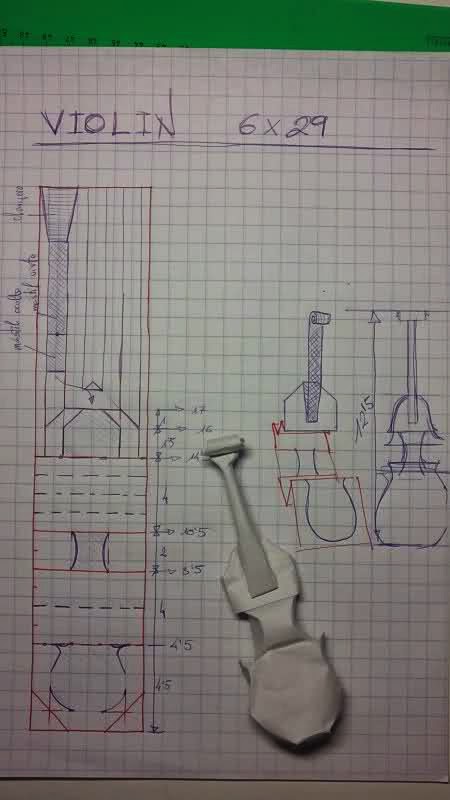The next
option I found was Leo Lai’s cello. Both the CP and the final model can be
found in his flickr page. If you don’t know it, it is well worth a visit.
 |
| Leo Lai's cello |

When I analysed the CP I discovered a great design. The bottom of the paper is used to form the cello’s body. The upper part is used to form the strings, neck and scroll of the instrument. It is folded accordion like and then folded down to lay on the body using the string of diamonds in the middle of the paper. This last fold also produces the colour change of the strings, neck and scroll.
You can see it here in a very preliminary fold I made to see how the CP worked:
 |
| The top area is folded accordion like |
 |
| The top of the paper is folded over the bottom using the line of diamonds |
 |
| The final model, with a short neck, but useful to learn the folding procedure |
- Trying to fold the original model by Joisel
- Modifying Leo Lai’s design to lenghten the neck and reduce the number of strings from 8 to 4 turning the cello into a violin (although in Leo Lai's folded model you can only see 4 strings, when you fold the published CP you get 8)
To my
delight I found that just a few days before, a wonderful violin design by Gen Hagiwara had been published in the 143th number of the Tanteidan Magazine.
The concept
behind this model is the same as in the cello, a long stripe of paper, the
bottom to form the body and the top to form the strings, neck and scroll. I only had to choose
the proper size of paper (22x5,5 cm), paint it with brown and black water colour and fold it.
 |
| My final violin |
Although
Gen Hagiwara’s violin is beautiful I couldn’t stop thinking about Joisel’s one.
So I decided to give it a try. Using Jorge Gracia’s CP I made some small
changes, added some detail and ended up with this CP:
Here you
can see a simple photo diagram to help you fold the CP as well as a final photo
with the violin and the dwarf:
And as a
final reflection, I want to give some ideas on how to improve the design even
more. The three models, Joisel and
Hagiwara’s violins and Leo Lai’s cello are opened.
 |
| The back of the violin is hollow |
How could a
closed violin be designed? A possible solution could be to use a wider stripe
so that after folding the body we had more paper left. This paper could be
folded to form the back of the violin. I may try it one day if nobody does it
before. The model would be spectacular, at least the image of the model I have
in my mind!!!!
------------------------------------------------------------------------------------------------------------
A few days after I released this post an origami friend from Madrid sent me two Eric Joisel's violin CPs. We think that they were on his web. I leave them here as a curiosity. They are very, very similar to the ones I presented in my post. The model in the second photography is simply spectacular.
------------------------------------------------------------------------------------------------------------
A few days after I released this post an origami friend from Madrid sent me two Eric Joisel's violin CPs. We think that they were on his web. I leave them here as a curiosity. They are very, very similar to the ones I presented in my post. The model in the second photography is simply spectacular.















